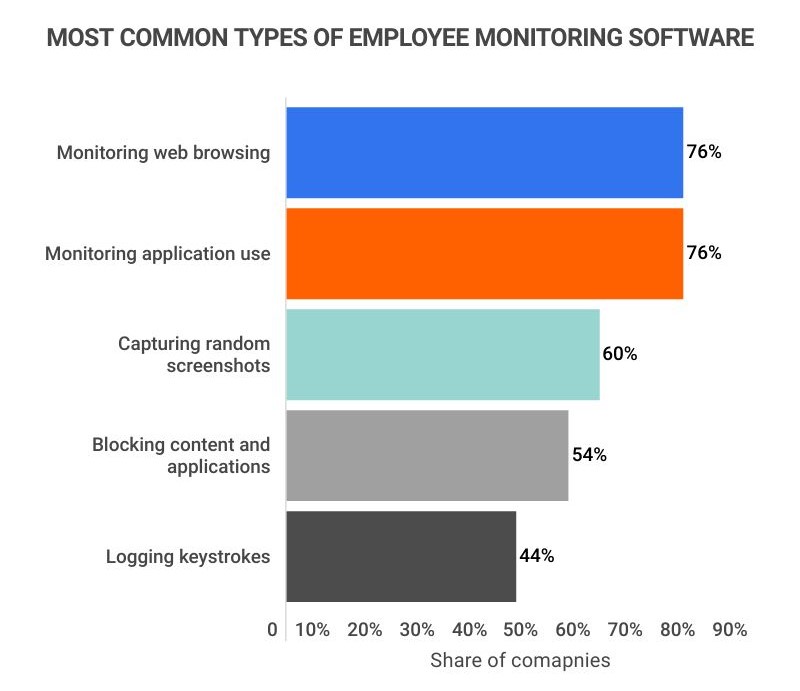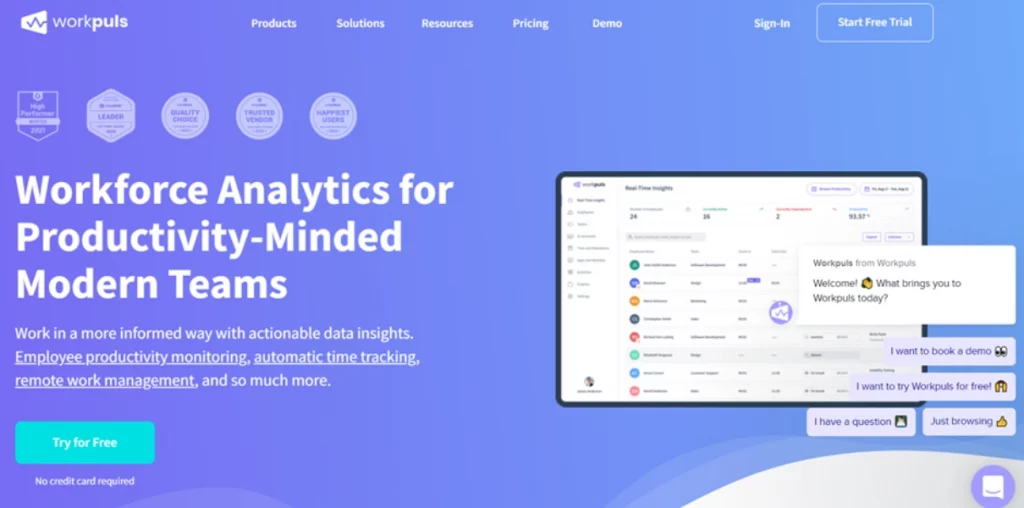It's a kind of software that allows organizations to monitor, track and document the actions of employees. Employers can collect data on employees' behavior, such as keyboard strokes, internet use, applications used, screenshots and much more. The primary purpose of software for monitoring employees is to increase productivity, make sure that employees are in compliance with company policies, protect sensitive data, and resolve security issues. When choosing an employee tracking software, there are a lot of aspects to take into consideration. Here are some important points to remember: Features- Determine which features you need, based on your organization's requirements. Common features include: activity monitoring (including blocking websites) Keystroke logging (including the tracking of usage on applications) and email monitoring and reporting. Make sure you prioritize features that are in line with your monitoring goals.
Compliance and Privacy- Ensure that the software complies with legal and ethical guidelines for employee surveillance. You must be familiar with the laws that apply to your region. For example data protection laws, as well as privacy laws. You should look for software that is flexible and transparent features to respect the privacy rights of employees.
User-Friendliness- Think about the software's simplicity of use and accessibility. Simple installation and a simple interface will make the installation easier and save you time. Look for customizable dashboards as well as intuitive tools for reporting and other features that let users to easily explore and understand the data you have collected.
Integration and compatibility - Verify whether the software integrates seamlessly with your existing infrastructure and other systems you currently use. This includes operating systems and email clients. The compatibility permits seamless monitoring of your systems without disrupting normal processes.
Data Security: Examine the security measures implemented by software in order to ensure the security of data collected. Access controls and encryption, secure storage of data, and compliance to industry standard security protocols are vital. Check the security practices of the software.
Scalability: Take into consideration how the software will scale to meet the needs of your expanding business. Select a program that can easily scale up to meet the requirements of your organization when you plan on adding more employees or new locations.
Analytics and Reporting- Evaluate the ability to report of the software. Look at features that give you a comprehensive view of employee performance, time allocation and trends. Customized analytics and reports can assist you in identifying areas for improvement and help you make educated choices.
Customer Support: Assess the quality of support for customers. You can assess their responsiveness, accessibility, and the technical assistance they offer. Customer support is crucial for ensuring prompt resolution of problems.
Cost- Think about the pricing structure of the software, whether it's a one-time purchase, subscription-based, or usage-based. Understanding the pricing structure and the additional costs, such as updates, support or other features is essential. Be sure to weigh the price of your product in relation to its value and features.
Transparency and Communication with Employees - Communicate clearly with your employees on the introduction of monitoring software. Be clear about the goal the scope, goals, and limitations of the monitoring. Inform them of how they can be protected, and also address the concerns of your clients.
After analyzing these elements it is possible to make an informed decision that fits your organization's specific needs and respects employee privacy while meeting all legal requirements. Take a look at the top employee monitoring services for site examples.

What Features Are Available In Employee Monitoring Software And How Do They Differ?
Employee monitoring software has numerous features to track and analyze the activities of employees. The features that are available may differ across different software solutions Here are a few typical features that are found in all employee monitoring software- Activity MonitoringThe feature tracks and records employee actions, including sites visited, apps used as well as the files that are accessed and the time spent on each task. It gives an extensive summary of the way employees spend their time working.
Keystroke Logging- Keystroke recording records every single keystroke entered by employees. It is useful for identifying productivity bottlenecks, detecting unauthorised activities, and gathering evidence during an investigation.
Screenshots, screen recordings and screen shotsScreenshots, and screen recordings - Certain applications take screenshots of the computer screen of employees at specified intervals. Others record their screen in real-time. This feature may be helpful for monitoring productivity or troubleshooting.
Internet Usage Tracking: This feature allows employees to track their online activities including the websites they visit, searches and downloads. It can help determine inappropriate use of the internet or security threats.
This feature monitors all the applications employed by employees in the workplace. It allows you to see which applications are the most popular and can help determine excessive or inappropriate application usage.
Email Monitoring: Employers can check the content of emails received and sent by employees, as well as attachments, as well as the contents of emails. It assists in ensuring compliance with corporate policies, to prevent data leaks and also look into any suspicious activity.
Tracking of documents and files This feature monitors access to, modifications to, and transfers. It can help protect sensitive information, monitor document collaborative work and ensures compliance with the security guidelines for data.
Remote Monitoring - Remote monitoring capabilities enable employers to supervise employees working remotely or work from different locations. Employers can keep track of the work of their employees and guarantee their productivity, regardless of where they are physically located.
Productivity Analysis. Programs for monitoring employees typically include features for productivity analysis that provide insight into employees' work patterns and levels of productivity. These analyses assist in identifying areas for improvement and optimize workflow.
Reporting and Analytics - The rich analytics and reporting tools produce elaborate reports that contain visualizations of data collected. These reports can provide useful information about employee performance, time allocation and resource management.
Software that provides features to manage compliance and policies can help ensure that an organization's guidelines and policies are followed. Employers are able to set and enforce corporate policies regarding acceptable use of computers.
Alerts/Notifications: Notifications and alerts inform managers or employers when certain activities or events occur. They can be used to notify you of any unusual behavior, like excessive internet usage or attempts to gain access to restricted sites.
Be conscious that various employee monitoring software might have different capabilities and features. Be aware of the features offered by software that is compatible with your goals for monitoring and adhere to the ethical and legal standards within your region. Follow the top employee monitoring software for website info.

What Is The Best Software For Monitoring Employees? Adhere To Privacy And Privacy Law?
It is crucial that employee monitoring software conforms to compliance and privacy laws. While the legal requirements can vary depending on the jurisdiction but there are a few typical ways that software for monitoring employees conforms to privacy and compliance law. Consent & NoticeMany areas require employees to provide informed consent as well as receiving prior notice of any monitoring activity. The software used to monitor employees typically has tools that permit employers to clearly communicate their monitoring policies to employees in a clear manner. This could involve giving written notices, getting consent on consent forms, or creating an employee handbook that details monitoring practices.
Transparent Monitoring Policies - Transparent monitoring policies promote transparency by making employees aware of what data is being collected, the reasons they're being monitored and the extent of monitoring. Employees will be able to know their rights to privacy and the limits of monitoring when policies are precise and complete.
Data Minimization: To guarantee that employee monitoring programs comply with privacy laws They usually adhere to data minimization. That is, only the necessary information is stored and collected. Data that is not needed or excessive is not required to be gathered. By limiting data collection to what is essential for monitoring This software decreases privacy risks and encourages compliance.
Anonymization or Aggregation: Some software designed to monitor employee behavior can anonymize and aggregate data to safeguard the privacy of employees. Data gathered is anonymized to remove personally identifiable information. Data from several employees is combined to give insights on a group-level without identifying individuals.
Secure Data Storage and EncryptionEmployee monitoring software is a key component of the safety of data it collects. It generally utilizes secure data storage practices and encryption techniques to safeguard information from unauthorized access, breaches, or accidental disclosure. This includes security for data while in transit and at home.
Access Controls with Restricted Rights- To ensure compliance, most employee monitoring programs include access control as well as restricted rights. Employers have the option to restrict access to monitoring data only to those with legitimate requirements for example HR personnel or the designated administrator.
Rights and Remedies for Employees Rights and Remedies - Respecting employee rights is an essential aspect of complying with privacy and compliance laws. Employee monitoring software usually includes options that allow employees to review and update their own monitoring records and make complaints. Employees can claim their rights and seek remedies in cases of privacy breaches.
Conformity to Data Protection Regulations – Employee monitoring software is designed in accordance with applicable laws on privacy of data, including the General Data Protection Regulations (GDPR) within the European Union, or the California Consumer Privacy Acts (CCPA) which are in the United States. The compliance process involves the implementation of measures to safeguard personal data and respecting the rights of data subjects and ensuring that the processing is legal of data.
While software for monitoring employees may assist in compliance efforts in certain instances, it's equally important to seek legal advice from professionals to stay up-to-date on the applicable laws and regulations within their area of responsibility. To adhere to the laws governing privacy and compliance an extensive approach is essential that goes beyond software. It should include clear policies and education for employees, as regular monitoring of compliance. Take a look at the best employee monitoring software for site advice.
